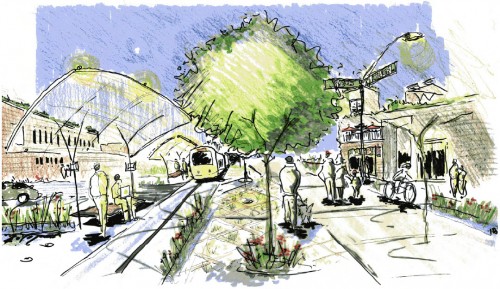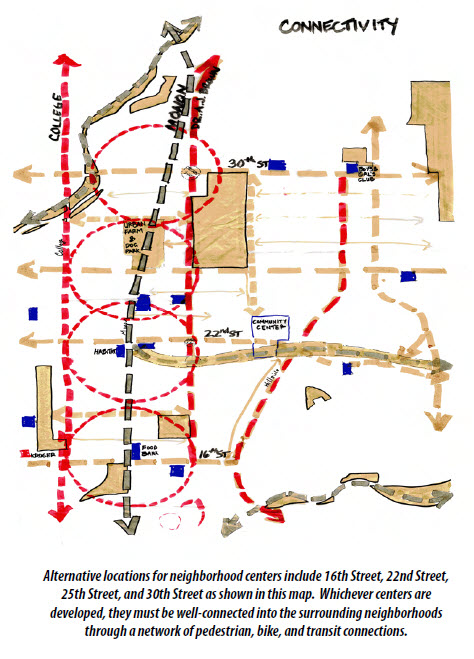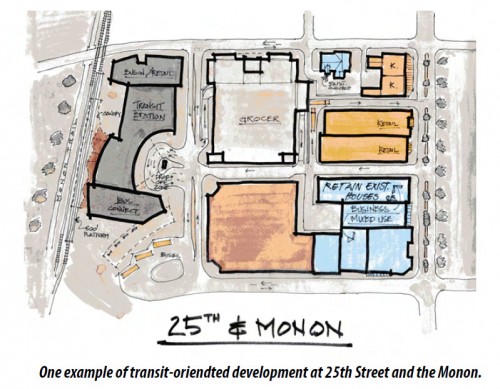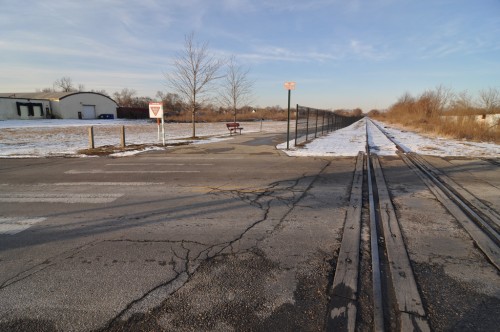Over the next five weeks I will profile 5 possible neighborhoods poised to benefit from the controversial NE Corridor line in Indianapolis that fall within the Marion County portion of the line.  The corridor in focus is one proposed by Indyconnect, and would originate at Union Station in downtown Indy, and terminate in downtown Noblesville, on the region’s NE side. It would be the first rail transit of any kind in the Indianapolis area since the interurbans were dismantled. The neighborhoods in focus, have already begun some sort of station area planning as part of a neighborhood revitalization plan, or make good sense to be considered for such.

22nd Street
In 2009, an iniative was launched to explore revitalization of an area that borders the Monon Trail and lies between 16th street, and 30th street. The inniative, named the Indianapolis Smart Growth Renewal District Partnership, looked at the history of the neighboorhood and formulated a plan to revitalize it from years of decay that currently plague the area.  The area’s history is industrial in nature resulting in a number of brownfields, and by extension, urban blight. Many properties, commercial and residential, are abandoned and have been cited as trouble spots by the city. Crime, rumored disease and lack of property upkeep have been pointed out. Those that currently live in the neighborhood have displayed a willingness to be involved in communicating how the future should look.

The plan centers on 22nd Street & the Monon Trail where The Project School is currently operating inside of a rehabbed warehouse, embodying the spirit of the plan. Future plans call for remediation of the brownfields in the area in the form of parks or pedestrian gathering areas and transit oriented devlopment surrounding transit stops in the area. One proposed stop could be located at 22nd street; however planners advocate for up to 3 stops in the area. Whichever area is slotted as the neighborhoods hub, connectivity to the rest of the area is key in promoting the revitalization.
The Indyconnect plan is not clear yet on how many stops will be located in the area. Due to it’s commuter rail status, building enough developer support will be key. Typically, “light rail” offers headways of 10-15 minutes and more frequently spaced stops which are obviously more attractive than “commuter rail” service of generally 20-30 minutes and station frequency generally measured in MILES rather than feet. The fact that the NE Corridor is new, should be promoted as a reason for attracting property developers to the area.

Another fact that will be pivotal in making sure that mixed incomes are addressed equally, will be city involvement. Most developers, left to their own devices, will plan higher income developments hoping for a large payoff. Most developers refer to this reasoning as “market demand”. As we often see, market demand doesnt drive urban property development as said private developers claim. In most areas of America where transit oriented development occurs, mixed income neighborhoods are constructed at the urging of city planning departments and political will. Another portion of this plan which speaks to me, is that many schools are located and planned for. This is another area where private development typically keeps it’s hands off the table. Insuring that public & private schooling is properly connected, will be a key responsibility of the city when it comes to promoting proper development patterns.

Conclusions
As you can see by reading only a few pages of the report (which is 122 pages), the neighborhood revitalization plan is 100% based upon a rail line being built through the middle of the area. Without the transit line, the plan would likely be changed. You even get the sense that the planner’s have hung their entire case on this notion. What will happen if the line is not built? Will the neighborhood continue to fall into disrepair? Will another plan be hatched? Where will funding come from? As such, energy is building in this neighborhood soley because a transit line has been announced to someday travel through it. Any changes that might jeopardize that energy should be closely examined by planners and addressed accordingly with stakeholders.
Next week’s post will center on the region loosely defined as “71st & Binford Blvd” where a neighborhood group has already published a station area plan based upon the same NE Corridor line.
I am still unsure how this stop will do. I view more as a loss leader, a stop that will not promote the large scale TOD because it is near downtown and might have little trip generation or trip endings. I know it can still be made and reshaped to something that will be enhanced by transit, but I fail to see a huge draw of users that might be from downtown or up north.
I wonder about that too Joe. When I wrote about the frequency and stop spacing of light rail, that also belays a better sense of connectivity. Better resource. etc. I fear that all these neighborhoods along the NE Corridor will fall into the same traps. Hedging on a commuter line to push development when light rail frequency would be better.
Being that this line plans to run all day long, even if on 30 minute headways, is better than peak only service though. It should be interesting to see how the plan is constrained in the end. It could be key to how development occurs
So when will a decision be made about the final plan? How much of an influence will Smart Growth Indy have on this plan?
I think the IRTC gets back together in February to hack through this thing (Indyconnect plan) and give the final version. They met in December to offer a blessing on it in the sense that they didnt bury it. There was a lot of bickering over what areas will get what kind of service and other such rhetoric.
It will all be up in the air anyway until the funding question is solved. The long range plan is a FISCALLY constrained plan. If there is no money to fund it, then its not technically in plan.
As for how much influence the Smart Growth people have, I would say a lot. Some of hte same people have a seat at both tables .
Regarding mixed income development opportunities in this area, you may be interested that a 62 unit mixed income project is currently under construction across from the Project School. It is called the National Apartments and being built by a private developer.
The same developer – Development Concepts, Inc. – is responsible for the Project School being located in the neighborhood, and has been heavily involved with residential construction and rehabilitation in the neighborhood for the last 10 years – well before the “Smart Growth” plan was completed.
http://martindaleonthemonon.com/
That’s great to hear about the National Apartments. I noticed the land clearing a few weeks ago and thought a few more of these projects could actually start to spur something for Martindale on the Monon. It may take a while but the combined elements of a lightrail connection (and the existing Monon Trail), downtown’s proximity, College Avenue, and most importantly much vacant land to be developed in the future COULD justify this area as one of the more important development districts for the city. The near northside is desperate for some viable commercial development.